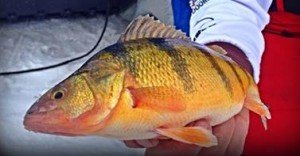 Catching Fish during a Tough Bite
Catching Fish during a Tough Bite
Cold temps have kicked-in all across the Midwest and lots of lakes are averaging 20+ inches of ice. February can be a challenging month for Hardwater anglers because of: cold temps, snow drifts on lakes, ice thickness and low oxygen levels in water. When the bite slows down and fish appear on your Vexilar but don’t bite, it’s commonly called “Negative Fish.” Over the last couple weeks, I’ve been chasing Walleyes/Jumbo Perch/Crappies in Minnesota, North Dakota & South Dakota; below are a couple tactics that helped during my Ice Fishing adventures.
Go Deep – Last weekend I was at the Minneapolis Boat Show talking fishing @ the Alumacraft booth (anxiously waiting to test drive their new Tourney Pro Sport 185) and the most common question folks had pertained to water depth vs. active fish. Fish are still active in February but they typically move deeper where the oxygen levels are higher. Kinda like going Elk Hunting out West in the mountains, when you chase Big Game in higher elevations you get tired quicker because of lower oxygen levels. Same logic applies to the Hardwater in February, so look for deeper holes or basins in your favorite lakes.
Move Around – Couple days ago, I stopped at Wing N Fin Resort on Lake Traverse MN (www.wingnfintraversemn.com) to work a couple rock piles for Walleyes & Crappies. I found great structure where the water column changed from 11ft to 4ft in <10yds. So I drilled multiple holes at 7ft, 8ft, 9ft, 10ft & 11ft – then I “flagged” for active fish by jigging aggressively with an artificial minnow or Chubby Darter (www.salmofishing.com) about 1-2ft off the bottom. It was the “dead sea” until I hit 10ft, then “bam” a Crappie smoked by lure. Even though my 10ft holes were literally 5 steps from the 9ft & 11ft holes, it was the deeper water column that was holding Crappies. Typically the first fish to bite in a new hole will be the Alpha or Biggest; so be prepared when “flagging” fish in a new hole. After educating Crappies on a couple hits on my Chubby Darter, I then switched to a smaller jig with plastics/wax worms.
No Time for Pictures – When fish get their “feedbag” on it February, it can sometime last for only a couple minutes; I especially find this true for Jumbo Perch. I specifically use the Clam jigs made of Tungsten because I know this little jig will have good presentation and fly down the hole 20-30% faster than Lead. When then Jumbos get aggressive, take advantage and do pictures later; as you might only have 1min to hook a few beauties.
If temperatures warm up in late February and oxygen levels follow suit, fish will move back towards weed lines/structure in shallower water. But we’ll chat about that later as today’s temperature is a beautiful -10 degrees!!! Be safe and have fun out there…..
Boomer Stelmach